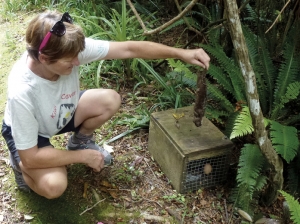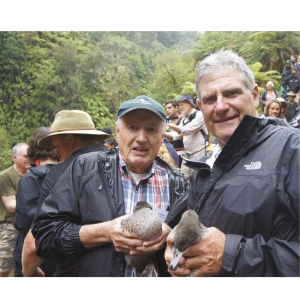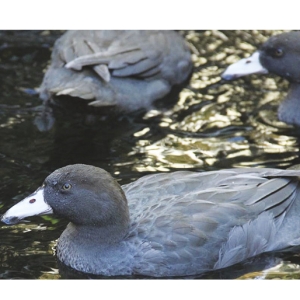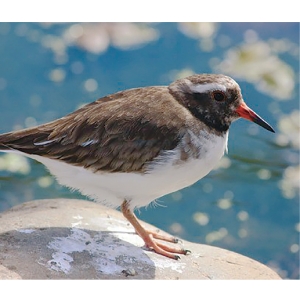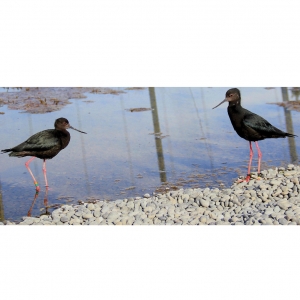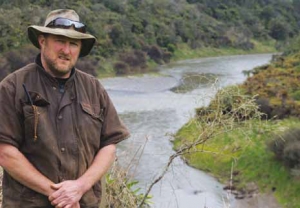Displaying items by tag: Whio
Protecting Whio
Keen predator hunter protecting Whio
The Ruahine Whio Protection Trust (RWPT) is a registered charity formed in late 2014 and functions though the efforts of a small group enthusiastically lead by chairwoman Janet Wilson. Its purpose is to raise funds to help protect and raise the number of Whio in the Ruahines and surrounds.
Janet has tramped for years in the Ruahines as a member of the Palmerston North Tramping and Mountaineering Club (PNTMC), and whio are often spotted on the river. Although being a protector of whio was not Janet’s original ambition, she took the opportunity to become a protector of the whio living and trying to survive in the area. Janet took over the running of the Oroua Valley Blue Duck Protection project from the NZDA (Manawatu Branch) in 2011. This expanded in to the Pohangina River in 2012.
“Life hasn’t been the same since,” said Janet. Trapping began in the Ruahines in 2007. Several groups now look after approx 1800 predator traps, predominantly DOC 200’s. These range from the Aorangi–Awarua Trust’s lands in the North to the Pohangina River in the South. In 2015 a Ruahine Whio Management Plan was developed by these groups with support from DOC, and along with the RWPT, they now make up what is known as the Ruahine Whio Protectors Collective.
Janet still coordinates the Oroua and Pohangina projects. Between July 2015 and June 2016, 110 stoats and weasels were caught, as well as 450 rats. She has a good team of willing volunteers but is always keen to hear from experienced trampers and hunters who might like to help out the whio. For many a tramp in the bush is no longer just a Sunday outing. It has become an ongoing war against the stoats, weasels, rats, and any other likely whio enemy.
Whio are the most endangered bird in the Manawatu and Janet is keen to raise the profile of our $10 duck locally. Janet said the Oroua and Pohangina rivers have the most southern population in the North Island. There are no known whio in the in the Tararua and Rimutaka ranges.
Restoring the balance for whio
Horizons Regional Councillors joined DOC representatives and iwi at Blue Duck Station in February 2017 for a whio release, during a tour of the northern parts of the ManawatuWhanganui Region. Blue Duck Station set within the Kia Wharite project, has seen Horizons, DOC, Whanganui iwi and
private landowners working in the private lands and remote forests around Whanganui National Park to improve land, water and biodiversity, while enhancing community and economic wellbeing. Kia Wharite is one of the largest projects of its kind in New Zealand in scale and scope.
Back in February, way before the weather bomb hit Blue Duck Station, (see page 7) Horizons Regional Councillors joined the Department of Conservation (DOC) deputy director general operations, Mike Slater, and iwi representatives for the release of 14 whio at Blue Duck Station.
The whio release was a hands-on opportunity to show how Kia Wharite, a collaborative biodiversity project in the Whanganui/ Ruapehu districts, is directly contributing to the survival of native species.
Since 2008, Horizons, DOC, Whanganui iwi and private landowners have been working in the private lands and remote forests around Whanganui National Park to improve land, water and biodiversity health, while enhancing community and economic wellbeing. Kia Wharite is one of the largest projects of its kind in New Zealand in terms of scale and scope.
The Kia Wharite project spans over 180,000 hectares and includes a mixture of private land and parts of the Whanganui National Park, the second largest lowland forest in the North Island. This remote area is home to the largest population of Western North Island brown kiwi and plays host to many native bird and plant species.
Possums, goats, stoats and other predators have threatened the health of the forest and put the long-term future of its inhabitants in jeopardy.
Horizons Councillor Bruce Rollinson said as part of the project extensive possum control operations have been undertaken by Horizons and OSPRI on rated land, and DOC on crown land. OSPRI have signalled a phased withdrawal from areas inside the project sites, as these areas are declared TB free. Currently approximately 150,000 hectares of land has regular possum control undertaken in the project area.
This work, alongside pest and weed control, protecting bush and wetlands and monitoring threatened native species, is also why it was possible to release 14 whio into the Kaiwhakauka Stream. Here, whio are protected on the river through a network of traps managed by Blue Duck Station volunteers to target stoats, said Cr Rollinson.
Predator control is carried out in the wider whio security site by Horizons and DOC; over 85 km of trap lines are in place along the Retaruke and Manganui o te Ao rivers, providing necessary protection for whio.
Department of Conservation deputy director general operations Mike Slater said with a population of fewer than 3000, this national whio security site is one of eight locations identified across the country as being essential for whio recovery.
With the support of Genesis Energy, DOC has been able to double the number of fully secure whio breeding sites, boost pest control efforts and enhance productivity and survival of these rare native ducks. The ultimate goal of this security site is to achieve protection to 50 breeding pairs, said Mr Slater.
Whio are adapted to live on fast-flowing rivers so finding them means you have also found clean, fast-flowing water with a good supply of insects. This makes whio important indicators of ecosystem health, they only exist where there is high quality, clean and healthy waterways.
It is not just whio and the environment that benefit from the project. Horizons and DOC believe there are positive economic returns to be had from the project. Blue Duck Station is the most obvious example.
The sheep and beef cattle farm, located 55km south-west of Taumarunui, is set on 2915 hectares of medium to steep hill countryDuck Station owner and manager Dan Steele said grazing areas have been deliberately offset by native bush and manuka. “Through the Kia Wharite project, we have
worked closely with Horizons and DOC to develop a sustainable land plan, and fence ofselected farm areas to protect native fauna and flora,” said Dan Steele.
“The Station has approximately 450 traps for stoats, mustelids, feral cats, rats, mice and hedgehogs; all enemies of the blue duck as well as other native species. In partnership with Kia Wharite, we maintain and reset the traps approximately every two weeks; this is undertaken mainly by our olunteers or ecowarriors as we call them.
“Embracing the environment in this way provided the perfect place to set up a lodge and tourism operation. In a relatively short time we have grown to approximately 8000 visitors a year, many of whom become ecowarriors during their stay,” said Dan Steele.
Cr Rollinson said Kia Wharite is proving to be a successful approach, with the project already exceeding some of its goals. “It shows what can be accomplished when organisations join forces and work collaboratively.”
Whio in decline
Whio in decline…
The whio (blue duck) is one of New Zealand’s ancient endemic waterfowl species and is classified as Threatened (Nationally Vulnerable) in the New Zealand Threat Classification System 2012, and listed as Endangered on the IUCN Red List of Threatened Species.
North Island and South Island whio populations are genetically distinct (though they are not described as sub-species) and are treated as separate management units. The whio has experienced rapid declines (particularly in the South Island) in abundance and distribution, nowhere common. It lives at low densities in severely fragmented populations. The most recent estimate of total population numbered 1200 pairs at most.
The most notable decline driver comes from introduced mammalian predators, with predation of eggs, young and incubating females. Stoats are the most significant threat and stoat control is a main focus of management activities.
The blue duck’s widespread decline throughout South Island beech forests areas has highlighted the insidious effects of mast-seeding beech trees, which result in great predation pressure, as rodent populations explode, causing a lagged increase in stoat populations which seek alternative prey when rodent numbers crash. A malebiased sex-ratio throughout the range, indicates that predation during incubation is significant.
One of the major conservation management tools for whio is captive breeding for release into the wild. The blue duck has been held in captivity for many years, and its husbandry requirements are understood. The aim is to maximise productivity of the captive breeding programme, and ensure that captive-bred ducklings are released at the highest priority sites. Captive breeding has proven highly effective, and is vital in aiding the recovery programme with the re-establishment and rebuilding of viable populations throughout the former range.
The Isaac Conservation and Wildlife Trust provides the largest output of blue duck juveniles annually, with its waterfowl aviaries being the most successful captive breeding enclosures in New Zealand for North Island blue duck. The Trust currently holds two North Island blue duck breeding pairs. These breeding pairs can lay up to three clutches per season, with an average of six eggs per clutch. All eggs are collected for incubation and hand rearing.
The Trust is a significant participant in the WHIONE programme, which consists of retrieving wild eggs each breeding season from South Island pairs for artificial incubation and rearing in captivity, with a subsequent release of juveniles once fledglings have been hardened in our fast water facilities and are at a lower risk of predation. Releases take place in natal territories or at new sites around the South Island to increase numbers and genetic diversity across sites or re-establish lost populations. Since 2016 the Trust has been retaining cohorts of South Island blue duck juveniles for flock mating, to initiate a captive breeding population across several South Island facilities. The Trust will move out of North Island birds and hold three pairs of the South Island blue duck.
Each season for the last 12 years, the Trust has also received North Island blue duck juveniles bred by other captive institutions nationwide, which are transferred for pre-conditioning in fast flowing raceways prior to release into the wild.
Sabrina Luecht
Wildlife Project Administrator
The Isaac Conservation and Wildlife Trust
Fears for Whio
Fears for whio after weather bomb
February (2017) brought a highlight on the conservation calendar at Blue Duck Station – the release of 14 rare juvenile blue ducks (whio) into the Kaiwhakauka Stream.
After months of preparation in which the young whio were raised in captivity and prepared for life in the wild on an artificial stream, teams from Blue Duck Station, the Department of Conservation (DoC), Horizons, and Whio Forever saw the ducks off into their new home as part of a community event at Blue Duck Falls. A representative from the local iwi blessed the ducks before volunteers released them into the Kaiwhakauka, watching as they swam upstream into their new habitat. The long term aim is for the ducks to form breeding pairs along the length of the Kaiwhakauka stream, further strengthening the local whio population.
Unfortunately, the joy was short lived. In March a weather bomb wreaked havoc along the Kaiwhakauka. Over 100ml of rain fell in one day, causing flash floods and land slips that battered the Station. The environment around the Kaiwhakauka changed drastically – fallen trees and boulders littered the river, while flooding risked washing away the newly released whio. High water levels also threatened the whio’s ability to feed in the stream and with the stream bed turned upside down, it is unclear how much feed is left for the ducks.
While the damage is severe, the team at Blue Duck Station remain optimistic. In the coming months they will be assessing the impact and planning how best to help the ecosystem recover. Sightings of juveniles have continued in the surrounding areas since the floods, so hopes are high that habitats can be restored for further releases in the future and that Blue Duck Station will continue to be a haven for whio.
Maxine Ross, David Atkinson.
Shore Plover breeding success at Pukaha Mount Bruce
The mission to save more than one endangered bird species has been enriched by last year’s successful breeding programmes at Pukaha Mount Bruce.
The Shore Plover programme saw over 10 birds transported from Pukaha Mt Bruce National Wildlife Centre to Motutapu Island in the Hauraki Gulf and Portland Island off the Mahia peninsula.
The shore plover is in a perilous position with fewer than 200 left in the wild and a history of conservation efforts being hampered by rat infestations. Shore plover were first spotted by observers on Captain Cook’s second voyage to New Zealand.
The shore plover is the most endangered bird reared and cared for at the centre. It is very susceptible to mammalian predators, even one rat can cause enormous damage.
Past Department of Conservation attempts to establish shore plover on Mana and Portland Islands were undone by what was thought to be a single rat in both cases.
The breeding and hatching of over 10 chicks at Pukaha had been a real triumph for the staff and wider conservation efforts.
In another success for the breeding programme, there were also over 10 pateke (brown teal) bred and hatched at the centre in the last breeding season.
The endangered ducks have a wild population of between 2,000 and 2,500 making them New Zealand’s most rare mainland waterfowl.
As well as great results in the Shore Plover and Pateke recovery programmes, the Whio (Blueduck) also produced more than one clutch of ducklings.
Pukaha’s new free flight aviary that opened in May 2016 enabled the breeding pair of Whio that call it home, to lay eggs which were then artificially incubated and hand-reared. Those ducks were sent to Turangi where they spent time in a purpose-built environment to prepare them for release to the wild.
The second clutch of eggs is allowed to stay with the parents and be raised naturally.
The theory is that by letting the parents raise them, the ducklings will be better parents when it is their time to breed.
By Illy McLean and Laura Hutchinson
Spring Has Sprung
The 2017/18 breeding season has begun and The Isaac Conservation and Wildlife Trust (ICWT) once again reached its busy rearing phase.
Early October saw the collection of the first clutch of critically endangered New Zealand shore plover eggs for artificial incubation. Critically endangered black stilt/kaki pairs had also begun laying eggs.
ICWT is happy to report that three clutches have been incubated by critically endangered orange-fronted parakeet breeding pairs, as well as eight healthy chicks presently being raised. (see page 9).
The first South Island blue duck/whio ducklings hatched, while North Island ducklings hatched soon after. Meanwhile five brown teal/pateke pairs have hatched ducklings and more will be on the way.
ICWT’s reptiles are becoming more active with the warming weather, meaning tuatara, Otago skinks and grand skinks will be breeding as well.
As always, ICWT’s ambitious native planting programme across the Isaac Conservation Park and the Otukaikino River restoration site continues; while salvaged historic buildings continue to be restored to their former glory in the Heritage Village.
For more information see:
http://www.isaacconservation.org.nz/
https://www.facebook.com/ICWTNZ/
Sabrina Luecht,
Wildlife Project Administrator,
ICWT
Out there for the Long Haul
written by Lou Sanson, Director General, DOC).

